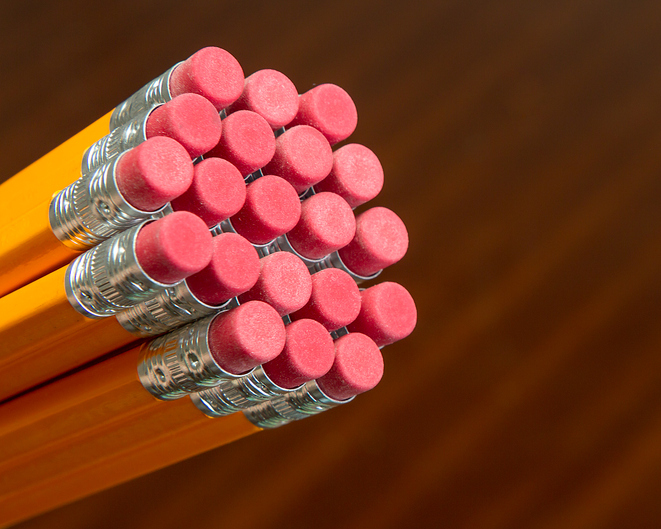Close your eyes and think back on your school days. Picture that chalkboard and the hand-cranked pencil sharpener, and that soft pink eraser in your desk. Here’s where all that stuff came from. (This article was first published in our 31st annual edition, Uncle John’s Actual and Factual Bathroom Reader.)
Pink Erasers
The Faber-Castell Company had been making pencils in Bavaria since the 1760s. Fourth-generation operator John Eberhard Faber took over in the 1850s and moved the company to Greenpoint, Brooklyn, where he opened America’s first pencil factory in 1861. Soon after, the company secured a contract to make a line of pencils to be sold at Woolworth department stores. Marketed under the name Pearl Pencil, they were topped with erasers that combined rubber and pink pumice—volcanic ash imported from Italy. The erasers worked so well that Faber started making stand-alone erasers (for all those mistake-prone kids who wore out their pencil erasers before they wore out their pencils).
Pencil Sharpener
What’s the old-fashioned way to sharpen a pencil? Whittling away at the tip with a knife until it was fine. That was time-consuming, inexact, and, for children, potentially dangerous. In 1828 a French mathematician named Bernard Lassimone received a patent for the taille-crayon—literally, “pencil cutter.” A system of tiny metal files was ensconced in a block of wood, a pencil was inserted, and, as the pencil was slowly turned, the files whittled away at the pencil tip’s sides. It was safer than a knife, but apparently not much faster or cleaner. Inventors in Europe and North America kept trying to improve on Lassimone’s design until the 1840s when French inventor Therry des Estwaux came up with the idea to make the “pencil insertion chamber”conical and lined with blades—that way, when a pencil went in and was turned, every side was shaved down equally and all at the same time.
Blackboard
There’s archaeological evidence that students used something akin to individual blackboards as far back as ancient Babylonia. They didn’t have paper and pencils (or pens), so they took notes and wrote lessons on smooth clay tablets with a clay stylus. They’d erase the tablets by wiping them down with water, or writing could be made permanent with a simple bake in a kiln. Over the centuries and around the world, by the 18th century, clay tablets had evolved into “slates” in the West—tablet-sized writing surfaces made out of either actual slate or wood painted with slick, washable paint. Pro: They were cheap and reusable. Con: Teachers had no way to demonstrate a group lesson—they had to go from student to student to show them, for example, a math problem.
In 1801 James Pillans, the headmaster of Old High School in Edinburgh, Scotland, came up with a solution: He hung a very large piece of slate on the wall at the front of his classroom and wrote on it with a piece of chalk. The idea spread through Europe and then to the United States, where black slate was especially cheap and plentiful thanks to slate mining operations across the Eastern seaboard. The blackboard remained mostly unchanged until the 1960s, when a green-colored board—a steel plate coated with green porcelain enamel paint—was introduced. The new green boards were easier to read than blackboards from the back of a classroom, and chalk dust erased more efficiently. (But they were still called blackboards.)
Blackboard Eraser
All those blackboards had to be wiped clean with something. At one time, teachers used an old damp rag. But there were some downsides to that method: 1) it took the board a long time to dry, 2) it was messy, and 3) it left behind a lot of chalk dust. In the early 1860s, John Hammett, the owner of a Rhode Island school supply store that sold mostly slates and chalk, figured out a better way. A piece of cheap, dry felt was much more efficient than a wet rag. He commissioned an easy-to-handle, felt-wrapped item, and the first eraser that his team came up with is pretty much unchanged today.
An Apple for the Teacher
The origin of this custom is not definitively known, but here’s one reasonable theory: As settlers laid down roots in the American Midwest in mid-1800s, they opened small, one-room schoolhouses to teach the children. It was the responsibility of the community to find a teacher—almost always a young unmarried woman. And because they couldn’t afford to pay much, if anything at all, the community took care of the teacher’s basic needs as best they could. Someone might donate a home, for example, while parents of other kids might help keep her fed. An apple for a teacher was an outgrowth of that—a sweet treat for a job well done (in lieu of salary). But why apples and not, say, peaches or corn? Kids may well have brought those, too, later in the year. Apples may be the iconic gift for teachers because the beginning of the school year coincides with peak apple season in September.









